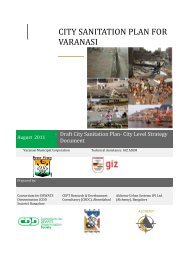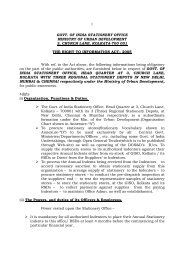CITY SANITATION PLAN - Ministry of Urban Development
CITY SANITATION PLAN - Ministry of Urban Development
CITY SANITATION PLAN - Ministry of Urban Development
You also want an ePaper? Increase the reach of your titles
YUMPU automatically turns print PDFs into web optimized ePapers that Google loves.
<strong>CITY</strong> <strong>SANITATION</strong> <strong>PLAN</strong> BAREILLY<br />
Source Characteristics Emptying and cartage implications<br />
Dry pits/vaults Highly concentrated quasi-solids Vacuum desludging systems are<br />
with high pathogen content required for cleaning <strong>of</strong> single pit<br />
(depending upon residence Latrines.<br />
time in latrine).<br />
Leach pits As above, but higher moisture content Twin pits can be emptied manually<br />
without the need for specialized<br />
equipment.<br />
Septic tanks Varies enormously depending Septage vacuum trucks are widely<br />
on the number <strong>of</strong> people utilizing utilized for cleaning <strong>of</strong> septic tanks.<br />
the septic tank, water consumption,<br />
tank size, and pumping frequency.<br />
Adopted from ‘A Guide to Decision-making—Sanitation Technology Options for <strong>Urban</strong> India’,<br />
<strong>Ministry</strong> <strong>of</strong> <strong>Urban</strong> <strong>Development</strong> (MoUD) with support from the Water and Sanitation Program South<br />
Asia.<br />
6.3.2 FINANCING OPTIONS<br />
Expansion <strong>of</strong> sanitation systems will not be possible unless an institution or group <strong>of</strong> individuals,<br />
preferably the intended users, are willing to pay user charges for the new facilities required. Even<br />
when facilities have been provided, they will fail sooner or later unless funds are available to cover<br />
their ongoing operation and maintenance. So, it will be impossible to first provide and then sustain<br />
services to cities as a whole unless the finances <strong>of</strong> those who are responsible for providing and<br />
managing them are sound. Most conventional financing goes to established services in already<br />
served areas and to conventional technological and administrative systems. This approach is not<br />
going to fulfill the sanitation target <strong>of</strong> the MDGs and beyond. To revise the current trend <strong>of</strong> an ever-<br />
growing sanitation backlog in poor urban areas we need not only to invest more and more wisely,<br />
but also finance in much more creative ways.<br />
Every proposal for a sanitation service, and its non-technical components, needs financing. The<br />
amounts required can be estimated in the early stages <strong>of</strong> strategic planning, and should include costs<br />
to be incurred by the municipal government and other parties. The strategy will consider both the<br />
initial capital and recurrent financing needs. The sustainability <strong>of</strong> most sanitation systems depends on<br />
ADMINISTRATIVE STAFF COLLEGE OF INDIA, HYDERABAD Page 162
















